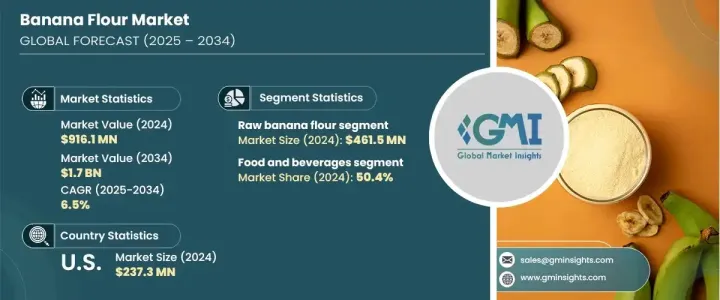
세계의 바나나가루 시장은 2024년에는 9억 1,610만 달러로 평가되었고, 2025년부터 2034년까지 연평균 복합 성장률(CAGR) 6.5%를 나타낼 것으로 예측됩니다.
글루텐 프리, 식물성, 영양 밀도가 높은 식품에 대한 수요 증가가 이 시장 확대의 원동력이 되고 있습니다. 소비자의 건강 지향이 높아지고 영양가가 높을 뿐만 아니라 환경적으로도 지속가능한 대체식품을 요구하는 바나나가루는 이상적인 솔루션으로 눈에 띕니다. 푸른 바나나로 만들어진 이 만능 가루는 식이섬유가 풍부하고 프리바이오틱스 효과도 있어, 글리세믹 지수가 낮기 때문에 식사 제한이 있는 사람이나 건강한 라이프 스타일을 목표로 하는 사람에게 있어서 매력적인 선택지로서 인지되고 있습니다.

오늘날 소비자들은 깨끗한 라벨 제품과 지속가능성에 더 중점을 두고 바나나가루의 매력이 더욱 높아지고 있습니다. 바나나가루의 제조 공정에서는 과도한 청색 바나나를 사용하여 식품 폐기물을 줄이고 환경 보호에 기여합니다. 이러한 환경 친화적인 측면과 기능적인 건강 효과가 결합되어 바나나가루는 다양한 제품에 사용됩니다. 또한 제빵, 스낵 과자, 식이보충제 등 다양한 산업에서 다용도로 이용할 수 있는 점에서 건강 지향인과 식물성 식생활을 보내는 사람들 사이에서 인기가 높아지고 있습니다.
| 시장 범위 | |
|---|---|
| 시작 연도 | 2024년 |
| 예측 연도 | 2025-2034년 |
| 시작 금액 | 9억 1,610만 달러 |
| 예측 금액 | 17억 달러 |
| CAGR | 6.5% |
시장은 유형별로 생 바나나가루, 완숙 바나나가루 등으로 구분됩니다. 2024년에는 생 바나나가루가 4억 6,150만 달러 시장 점유율을 차지했습니다. 소화를 돕고 체중 관리를 지원하는 높은 수준의 레지스턴트 전분을 포함한 우수한 영양 프로파일이 그 원동력이 되었습니다. 더 많은 소비자가 전통적인 가루를 대체하는 글루텐 자유로운 대안을 보는 동안, 이 부문은 큰 성장을 이루고 있습니다.
바나나가루의 인기는 식품 및 음료 산업에서의 사용 증가로 뒷받침되고 있으며 2024년 시장 점유율의 50.4%를 차지했습니다. 글루텐 프리로 기능적인 식재료 수요가 급증하는 가운데 바나나가루는 구운 과자, 스낵 과자, 식음료 등 다양한 식품 카테고리에서 중요한 성분이 되고 있습니다. 바나나가루에 함유된 식이섬유와 프리바이오틱스가 소화 촉진과 건강 전반에 도움이 되기 때문에 식이보충제에 대한 관심이 높아지고 시장은 더욱 확대되고 있습니다.
미국에서는 글루텐 프리, 식물 유래, 클린 라벨 식품으로의 전환이 증가함에 따라 바나나가루 시장은 2024년 2억 3,730만 달러에 달했습니다. 바나나가루의 소화기계에 대한 건강효과와 다양한 식생활에의 적합성에 대한 인식이 높아짐에 따라, 특히 음식 및 식이보충제 등 다양한 분야에서 수요가 계속 증가하고 있습니다.
The Global Banana Flour Market, with a valuation of USD 916.1 million in 2024, is projected to grow at a CAGR of 6.5% from 2025 to 2034. The rising demand for gluten-free, plant-based, and nutrient-dense food options is the driving force behind this market expansion. As consumers become increasingly health-conscious and seek alternatives that are not only nutritious but also environmentally sustainable, banana flour stands out as an ideal solution. Derived from green bananas, this versatile flour is gaining recognition for its high fiber content, prebiotic benefits, and low glycemic index, making it an attractive option for people with dietary restrictions or those striving for a healthier lifestyle.

Consumers today are more focused on clean-label products and sustainability, which further contributes to banana flour's growing appeal. The production process of banana flour uses surplus green bananas, reducing food waste and contributing to environmental conservation. This eco-friendly aspect, combined with its functional health benefits, has made banana flour a sought-after ingredient in a wide range of products. Additionally, its versatile applications in various industries, including baking, snacks, and dietary supplements, have led to its rising popularity among health-conscious individuals and those on plant-based diets.
| Market Scope | |
|---|---|
| Start Year | 2024 |
| Forecast Year | 2025-2034 |
| Start Value | $916.1 Million |
| Forecast Value | $1.7 Billion |
| CAGR | 6.5% |
The market is segmented by type into raw banana flour, ripe banana flour, and others. In 2024, raw banana flour accounted for USD 461.5 million of the market share, driven by its superior nutritional profile, which includes high levels of resistant starch that aid digestion and support weight management. This segment is seeing significant growth as more consumers turn to gluten-free alternatives to replace conventional flour.
Banana flour's popularity is also being fueled by its increasing use in the food and beverage industry, which accounted for 50.4% of the market share in 2024. As the demand for gluten-free and functional ingredients surges, banana flour is becoming a key component in various food categories, including baked goods, snacks, and beverages. The market is further expanding due to the growing interest in dietary supplements, where banana flour's fiber and prebiotic content offer digestive and overall health benefits.
In the U.S., the banana flour market reached USD 237.3 million in 2024, driven by a growing shift toward gluten-free, plant-based, and clean-label food products. As awareness of banana flour's digestive health benefits and its suitability for various diets increases, demand continues to rise across multiple sectors, particularly in food and beverages as well as dietary supplements.